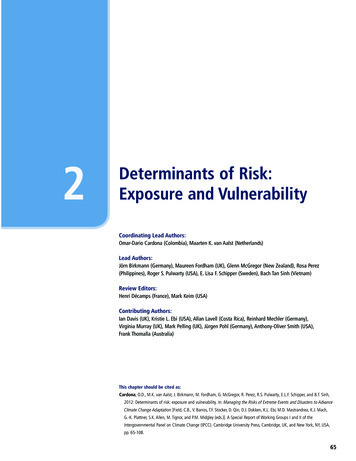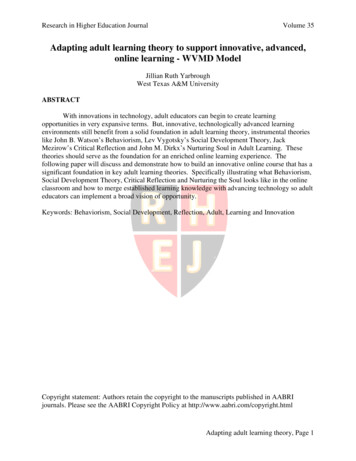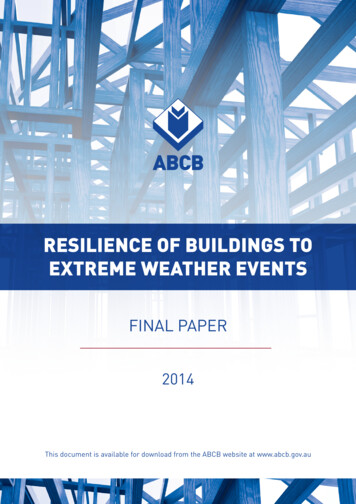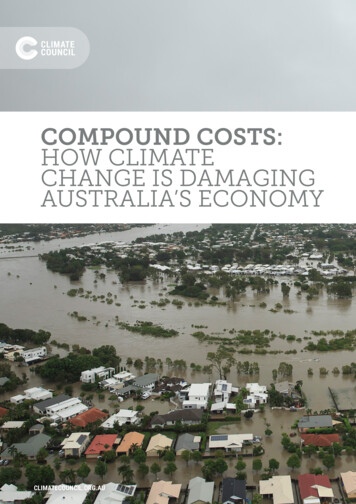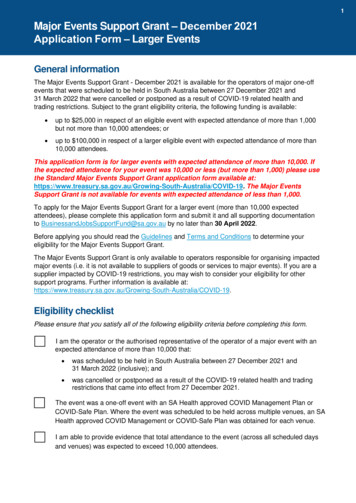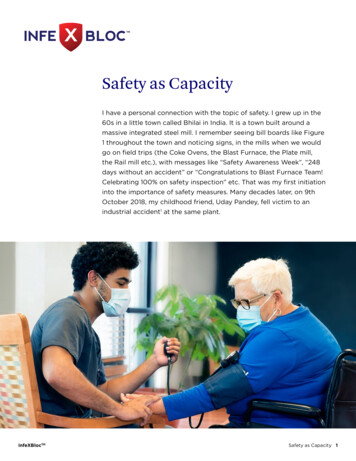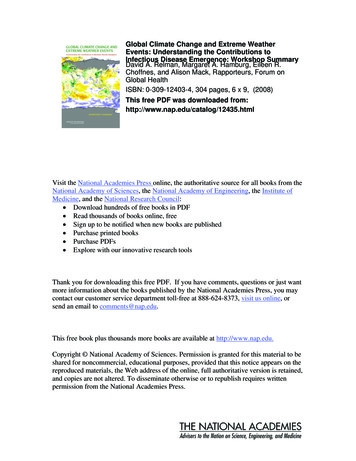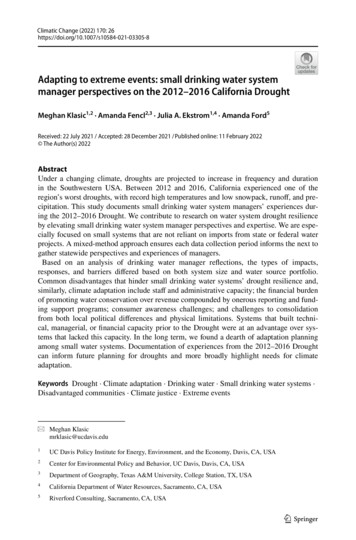
Transcription
Climatic Change (2022) 170: ng to extreme events: small drinking water systemmanager perspectives on the 2012–2016 California DroughtMeghan Klasic1,2 · Amanda Fencl2,3 · Julia A. Ekstrom1,4 · Amanda Ford5Received: 22 July 2021 / Accepted: 28 December 2021 / Published online: 11 February 2022 The Author(s) 2022AbstractUnder a changing climate, droughts are projected to increase in frequency and durationin the Southwestern USA. Between 2012 and 2016, California experienced one of theregion’s worst droughts, with record high temperatures and low snowpack, runoff, and precipitation. This study documents small drinking water system managers’ experiences during the 2012–2016 Drought. We contribute to research on water system drought resilienceby elevating small drinking water system manager perspectives and expertise. We are especially focused on small systems that are not reliant on imports from state or federal waterprojects. A mixed-method approach ensures each data collection period informs the next togather statewide perspectives and experiences of managers.Based on an analysis of drinking water manager reflections, the types of impacts,responses, and barriers differed based on both system size and water source portfolio.Common disadvantages that hinder small drinking water systems’ drought resilience and,similarly, climate adaptation include staff and administrative capacity; the financial burdenof promoting water conservation over revenue compounded by onerous reporting and funding support programs; consumer awareness challenges; and challenges to consolidationfrom both local political differences and physical limitations. Systems that built technical, managerial, or financial capacity prior to the Drought were at an advantage over systems that lacked this capacity. In the long term, we found a dearth of adaptation planningamong small water systems. Documentation of experiences from the 2012–2016 Droughtcan inform future planning for droughts and more broadly highlight needs for climateadaptation.Keywords Drought · Climate adaptation · Drinking water · Small drinking water systems ·Disadvantaged communities · Climate justice · Extreme events* Meghan Klasicmrklasic@ucdavis.edu1UC Davis Policy Institute for Energy, Environment, and the Economy, Davis, CA, USA2Center for Environmental Policy and Behavior, UC Davis, Davis, CA, USA3Department of Geography, Texas A&M University, College Station, TX, USA4California Department of Water Resources, Sacramento, CA, USA5Riverford Consulting, Sacramento, CA, USA13Vol.:(0123456789)
26 Page 2 of 25Climatic Change (2022) 170: 261 IntroductionClimate change is increasing the frequency and severity of extreme weather-related eventsglobally, leading to disastrous impacts on natural resources, infrastructure, and services onwhich people rely. Drinking water suppliers in California face challenges from continuedand future droughts and other extreme events; climate change is expected to amplify thesethreats. A recent extreme event, the 2012–2016 Drought in California (hereafter referredto as “the Drought”), was intense both in terms of its social and physical impacts. TheDrought offers the opportunity to learn from an extreme event that is expected to becomemore frequent and severe with climate change and population growth (Swain et al. 2018;Diffenbaugh et al. 2015; Seager et al. 2015; Williams et al. 2015).The goal of this research was to document empirically small, self-sufficient drinkingwater system managers’ perspectives, experiences, and needs for future drought resilience in the face of climate change and uncertainty. In this paper, we define self-sufficientwater systems as those that do not purchase or otherwise receive any water from the StateWater Project (state operated) or from the Central Valley Project (federally operated). Inour research, we underscore the importance of learning from local water system managersthemselves to gain insight into what drinking water systems need for climate adaptation toreduce future risks. Five key questions guided this study:1. How did small drinking water systems experience the Drought?2. Did small drinking water systems experience the Drought differently from larger systems?3. What are small drinking water systems’ needs for climate adaptation?4. Do small drinking water systems’ need for climate adaptation differ from larger systems?5. How did the state’s Drought policies and processes relate to small drinking water systems’ impacts and responses?We begin by giving an overview of California water management and the policy contextof the Drought before turning to a brief discussion of the literature on drinking water manager perspectives. Following, we review our three-stage methodology and findings. Finally,we discuss the implications of our findings for ongoing and future California water management, small systems’ resilience, and approaches to drought adaptation.1.1 The 2012–2016 Drought in CaliforniaCalifornia has a Mediterranean climate characterized by warm dry summers and cold wetwinters with periodic dry spells. Because of the wide variability in precipitation from yearto year, California relies on several major rainstorms annually, combined with a networkof storage, to overcome dry periods (Dettinger 2013, 2011). The state’s highly engineeredsystem of transporting water through the State Water Project (SWP)1 and the CentralValley Project (CVP)2 moves water through a system of reservoirs and canals from the1The SWP transports water more than 700 miles from northern to southern California and has been inoperation since 1962 (DWR 2021a).2The CVP includes 20 dams and reservoirs and more than 500 miles of canals, tunnels, etc. operated bythe US Bureau of Reclamation since 1940 (USBR 2021).13
Climatic Change (2022) 170: 26Page 3 of 25 26Sacramento-San Joaquin River Delta to urban centers and agricultural regions throughoutthe state. The southwest region of the US faces periodic droughts; however, the periodbetween 2012 and 2014 was the most severe drought in the region for the past 1200 years(Griffin and Anchukaitis 2014). While the lower rainfall and soil moisture deficits duringthe Drought were within California’s range of natural variability, the long warming trendand record high temperatures intensified its impacts (Berg and Hall 2015; Diffenbaughet al. 2015; Seager et al. 2015; Williams et al. 2015).During droughts, reduced availability of surface water pushes users to increase their reliance on groundwater sources, when available (Bostic 2021). Competing uses can impactthe availability of groundwater for domestic use in rural communities. A common consequence of the state’s increased reliance on groundwater during dry years is overdraft andsubsequent subsidence, which negatively affects isolated rural communities that have fewsupply alternatives to groundwater. During the Drought, groundwater dropped to or belowhistorically low levels in more than one-third of Sacramento Valley wells and more thanhalf of Central Valley wells (Jasechko and Perrone 2020; Pauloo et al. 2020; DWR 2014).The Drought also motivated the adoption of the Sustainable Groundwater Management Act(SGMA) in 2014 to help better manage this critical resource.The Drought exacerbated the vulnerability of drinking water suppliers, particularlysmall and rural systems that tend to have limited capacity to respond to drought and otheremergencies (Conrad 2013; DWR 2010). Even in 2010, the state recognized that “a fewhundred of the roughly 4000 smaller water companies in the state face running dry in thesecond or third year of a drought” (DWR 2010, p. 56). Many systems also face increasedwater quality problems during dry periods. As climate change amplifies drought risks,drinking water systems must find a way to manage water supply and maintain quality forimmediate needs and the future.To respond to the Drought, California Governor Brown declared a drought state ofemergency (Exec. Order B-17–2014) in January 2014 and, by April 2015, introduced astatewide policy of mandatory water reductions (Exec. Order B-29–2015). While a limitednumber of governmental and nongovernmental organizations have ongoing programs tosupport small water systems, the sheer quantity of small systems in California created aneed to document and reflects on their drought experiences.Learning from the recent experience of water systems during the Drought becomes evenmore relevant as California reenters an extreme drought and there is increasing attentionfor supporting small water systems. After declaring a drought emergency in spring 2021,Newsom proposed billions in targeted investments for immediate drought response andlong-term resilience support for water infrastructure (Newsom 2021; Office of the Governor2021a). With Governor Newsom’s signing of the Drought Planning: Small Water Supplier(SB 552) in September 2021, a subset of small water suppliers and schools are now requiredto develop water shortage contingency plans with specific drought elements (California Senate 2021). Additionally, all small water systems must incorporate drought planning into theiremergency response plans and meet new infrastructure requirements activated over the nextdecade. As part of a 15 billion California Comeback Plan (Office of Governor 2021b), 200million has already been distributed through the Small Community Drought Relief Program.This program was designed to offer financial and technical assistance to small communitiesfacing water supply challenges because of the current drought (DWR 2021b). As of October2021, funds supported water hauling, extended surface water intakes, and provided other reliefto small systems to adapt to drought-induced shortages. This suite of recent drought-focusedactions is layered onto an existing policy priority to achieve the state’s 2012 Human Right to13
26 Page 4 of 25Climatic Change (2022) 170: 26Water for all Californians (AB 685) (SWRCB 2021) and resolve California’s ongoing drinkingwater quality crisis (Balazs et al. 2021, 2011).1.2 Small drinking water systems, drought, and climate changeAs with most natural resource management, water management agencies have a history ofacting reactively rather than proactively to extreme events, hindering their capacity to adaptto climate change (Wilhite and Pulwarty 2017; Engle 2013; DWR 2008, 2011). Over the pastdecade, scholars and California’s water management agencies have called for the adoption ofa proactive drought management approach (Rossi and Cancelliere 2013; DWR 2011). Learning from the knowledge and perspectives of, and examining managers’ responses to, extremeevents like drought, provides a method to understand what systems need to adapt to a changing climate (Page and Dilling 2020; Dilling et al. 2019; McNeeley et al. 2016; McNeeley2014; Engle 2012, 2013). This bottom-up approach, or what McNeeley (2014) refers to as a“toad’s eye” perspective, provides “critical insights into local manifestations of drought riskand responses to better inform decision making for climate adaptation” (p. 1452).Drinking water managers experience drought in myriad ways that shape their short- andlong-term responses. Expanding the systems’ water supply portfolio is one of the most significant actions that managers take (Page and Dilling 2020), yet they must balance both spaceand time tradeoffs when connecting drought preparedness and adaptation (Engle 2013). Forexample, drilling new wells to expand supply in the short-term when historic over-relianceon groundwater during droughts can be maladaptive. In other instances, even if a system hasthe adaptive capacity, barriers may prevent enacting it (McNeeley 2014). Overcoming barrierslike political and public acceptance of managers’ proposed drought responses becomes just asimportant as the responses being technically feasible (Hornberger et al. 2015).In terms of how existing drought management will be affected by climate change, few studies focus on understanding the needs of small water system managers for preparing for climate impacts in high-income countries. A proactive drought adaptation agenda has yet to beimplemented to an equal degree across all water systems (Ekstrom et al. 2017; Wilhite andPulwarty 2017). This paper contributes to the literature on managing drinking water underclimate change and fills a need for research on small drinking water systems that are understudied often due to limited data (Dobbin and Fencl 2021; McFarlane and Harris 2018). Tofill this need, we gathered perspectives and experiences of drinking water system managers(hereinafter referred to as system managers) to understand the variable ways in which watersystems were impacted by and responded to the Drought. Furthermore, we explored the barriers to drought resilience and facilitated policy discussions on how to better align state policyand programs with small system needs. Our research underscores the importance of preparingfor and adapting to the increasing frequency and severity of extreme events under in changingclimate.2 Research design and methodsThere is a growing recognition of the need to employ a bottom-up, social science approachto adaptation like the one being employed in this project (Victor 2015; Mastrandrea et al.2010). Social science methods can be effective in offering a setting for the dialogue of different stakeholders and for collective input when conducted through group formats. Seeking to capture the needs of water system managers across California, we used an iterative13
Climatic Change (2022) 170: 26Page 5 of 25 26Fig. 1 Timeline of study process and events, indicating significant State of Emergency policy; total participants in this study include 185 individuals across 2 years (excluding the survey respondents)set of social science methods for data collection and analysis as illustrated in Fig. 1. Weinitially collected data through an online survey (results analyzed in Ekstrom et al. 2017)that influenced future data collection. This paper analyzes data collected from interviews,a regional workshop series, and a Policy Forum held in Sacramento with policymakers,government and NGO staff, and small system managers (for more information on methodssee, Ekstrom et al. (2018)).The timeline of data collection is notable given that climatic events shaped the experiences and perspectives of participants. The survey of system managers was conductedbetween July and September 2015 (a few months after an executive order requiring waterconservation, Exec. Order B-29–2015). Interviews with system managers were conductedbetween June and October 2016. The interview period coincided with the extended andrevised conservation mandate (May 2016) that required some water systems to (1) self-certify that they had sufficient supplies for three more years and (2) provide a localized reduction target based on a stress test (SWRCB 2016). During the first half of the 2016–2017water year (Oct. 2016–May 2017), the state received higher than average precipitation,leading the Governor to declare an end to the drought state of emergency in April 2017 forall but four counties (Fresno, Kings, Tulare, and Tuolumne). Regional workshops in Juneand July 2017 followed the wet winter, but many system managers still felt drought-relatedimpacts. The Policy Forum was held at the end of summer 2017, which allowed for a balance between emergency Drought management and nearing post-Drought reflection.2.1 Framing of adaptationWe employed a similar approach and principles developed in Moser and Ekstrom (2010)and applied in Ekstrom and Moser (2014) to identify the climate change impacts, adaptation strategies, and adaptation barriers. We relied on a similar definition of adaptation,13
26 Page 6 of 25Climatic Change (2022) 170: 26as changes in social-ecological systems in response to experienced or anticipated climate impacts, and the adaptation strategies and actions that facilitate changes operateover either or both short- and long-term periods. This definition has also been applied byother scholars (e.g., Ayeb-Karlsson et al. 2016; Herman-Mercer et al. 2016; Archie et al.2014).We used the adaptation barriers framework in Moser and Ekstrom (2010) to organize and identify barriers to climate adaptation and to characterize the types of strategiesundertaken by system managers during the drought. Examining extreme event impacts andresponses offers valuable insight into informing the needs for climate adaptation (Dillinget al. 2017; McNeeley et al. 2016; Engle 2013; Kates et al. 2012; Costanza et al. 2007).Therefore, we documented one recent extreme event—the Drought—to examine a watersystem’s response mechanisms and challenges. This offers a proxy view of the risks andchallenges that climate change could bring to these systems (Dilling et al. 2019; McNeeley 2014; Engle 2011). As others have pointed out, there are potential limitations inherentin using past events as analogs. First, by interviewing system managers during the heightof the Drought, it is possible we captured more temporary coping strategies than longterm transformative strategies (Ekstrom et al. 2018; Christian-Smith et al. 2015). Second,actions that help system managers adapt to impacts now do not necessarily translate intouseful actions for future impacts (Dilling et al. 2015; Engle 2012).2.2 Unit of analysisThe unit of analysis for this study is the drinking water system (n 49). Of the 49 watersystems represented, 15 are groundwater reliant, 13 are surface water reliant, and 21 areboth groundwater and surface water reliant. We focus specifically on water systems thatare both small and self-sufficient (referred to as S3 systems, n 24). Small systems refer tothose serving fewer than 10,000 people, and self-sufficient systems are those that are notreliant on either of the two large government-operated distribution systems (the SWP orthe CVP, or project water). For comparison purposes, non-S3 systems refer to water systems that do not meet both previously mentioned criteria (n 25). As such, non-S3 systemsinclude small systems with access to project water (n 3) as well as self-sufficient systemsthat serve more than 10,000 people (n 3).2.3 Three‑stage data collectionData were collected in three stages, each with unique methods: (1) interviews; (2) regionalworkshops; (3) Policy Forum. Each stage allowed the research team to validate and buildon its findings with different system managers to answer the research questions. Figure 1summarizes the project stages, the target population, and the number of participantsrecruited. Across the project stages, the team gathered input from 185 participants. Figure 2 shows the geographic coverage of input from system managers (a) and data collectionstages (b). During the first stage of data collection, we interviewed system managers togather perspectives on, and experiences with, the Drought. During the second stage of datacollection, we facilitated regional workshops with system managers and other stakeholders, like county agency staff, nonprofit organizations, and concerned citizens. This stagewas used to ground-truth interview findings; the perspectives of non-drinking water systemmanagers were not analyzed as part of this paper. In the final stage of data collection, thePolicy Forum convened drinking water stakeholders, including system managers and state13
Climatic Change (2022) 170: 26Page 7 of 25 26Fig. 2 a Map of small water systems serving 10,000 or fewer people (SWRCB 2016), record of purchasedwater from SWP or CVP (SWRCB 2014), and population density (U.S. Census Bureau 2016); b approximate locations of water systems that had managers participate in interviews and workshops; and approximate locations of regional workshops and the Policy Forumand nongovernmental organizations that play critical roles in supporting small water systems; we used the barriers identified in previous data collection stages as fodder to discussthe Drought and small water system needs with an eye toward developing potential solutions (see Online Resource 1).2.3.1 InterviewsThe research team conducted 58 in-person and phone interviews with system managersacross California. To gather experience representing a diverse set of systems in each geographic region, we identified a representative sample of managers using a coarse typologybased on source portfolio, size, and ownership type and reviewed them with key Californiawater informants (see Ekstrom et al. 2018). The interview protocol (see Online Resource2) was theoretically informed by the climate adaptation barriers framework described inthe Moser and Ekstrom (2010). Interview questions covered drought management, climate adaptation perspectives, water quality challenges, and the use of climate information.3 Interviews with non-water system entities were excluded from our content analysis.We inductively coded interview transcriptions using an online content analysis software,Dedoose . Following a coding structure described by Saldaña (2013), the research teamdeveloped a primary and sub-code scheme to relate thematic interview responses to theresearch questions and theory on climate adaptation barriers and information needs (seeOnline Resource 3). Coded excerpts were reviewed and analyzed inductively into categories based on emergent themes in the data (see Online Resource 4 for thematic categoriesand definitions).3Codes related to the use of climate information and water quality challenges were not used in this analysis. See Baker et al. (2018) for an analysis of climate information codes.13
26 Page 8 of 25Climatic Change (2022) 170: 262.3.2 Regional workshopsThe second stage of data collection sought to share, verify, and build-on interview findings through a collective venue, as suggested by Luyet et al. (2012) and Cornwall (2008).Three regional workshops convened local drinking water experts to review preliminaryfindings from the interview stage and to gather additional experiences and perspectives.We recruited a key leader in each region to co-host each workshop and invite attendees. Atotal of 71 people participated in the workshops, including representatives from approximately 37 water systems. We minimized the overlap of systems between the interviewand the regional workshop phase. Workshop participants represented system managers andlocal decision-makers that have direct experience working with small water systems, suchas County Environmental Health staff and State Board Drinking Water District Engineers.Workshops were organized in collaboration with and expertly facilitated by, the Environmental Justice Coalition for Water (EJCW), a nonprofit water justice organization working with and empowering underserved communities in California. EJCW was a key partner in identifying and recruiting water managers and justice leaders to participate in theworkshops.2.3.3 Statewide Policy ForumIn the third stage of data collection, we convened policymakers and system managers toreview and ground truth our findings and to facilitate discussion on potential solutions tosmall system needs. The Forum on Drought Resilience for Small Water Systems (PolicyForum) was held on September 20, 2017, in Sacramento, CA. The Policy Forum wasdeveloped in collaboration with and facilitated by EJCW. In ensuring that the agenda metthe needs of local stakeholders and decision makers, EJCW’s expert facilitation held spacefor discussion and reflection. Our partnership with EJCW was crucial to the success ofthe Policy Forum. Moderators facilitated small group discussions on existing and potentialstate policy efforts to better align with small drinking water system needs to overcomebarriers and achieve drought resilience. In total, 56 state and federal government staff, system managers, nonprofit and philanthropic organizations, and academic researchers participated in the Policy Forum, reflecting the ways in which water policy and small systemassistance go beyond government.3 ResultsIn the sections that follow, we
1 UC Davis Policy Institute for Energy, Environment, and the Economy, Davis, CA, USA 2 Center for Environmental Policy and Behavior, UC Davis, Davis, CA, USA 3 Department of Geography, Texas A&M University, College Station, TX, USA . "toad's eye" perspective, provides "critical insights into local manifestations of drought risk .


